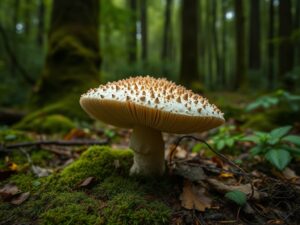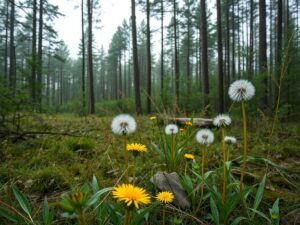Mushroom foraging in Canada draws enthusiasts to its vast forests and diverse ecosystems, offering a pathway to fresh, wild edibles. This activity connects individuals to the land while providing nutritional rewards. Proper preparation ensures success and safety in this pursuit.
Canada’s terrain supports a rich variety of fungi, from coastal rainforests to inland woodlands. Participants must prioritize knowledge of local species and regulations to maximize benefits. The process begins with understanding foundational elements.
Essential Tools for Safe Mushroom Foraging
Equipping oneself correctly forms the basis of effective mushroom foraging in Canada. Basic items prevent errors and protect finds.
Key tools include a reliable identification resource. For instance, mushroom foragers need Peterson Field Guide, which details North American species with clear illustrations and descriptions. This guide proves invaluable for distinguishing edibles from hazards.
A foraging tools include basket mesh bag allows spores to disperse, promoting ecosystem health. Opt for breathable materials to keep specimens fresh during collection.
For harvesting, carry a essential tools pocket knife scissors to cut stems cleanly without uprooting. Gloves protect hands from irritants found in some varieties.
| Tool | Purpose | Recommended Type |
|---|---|---|
| Field Guide | Identification | Peterson Field Guide to Mushrooms of North America |
| Basket | Spore Dispersal | Mesh or woven natural fiber |
| Knife/Scissors | Clean Harvest | Stainless steel, sharp blade |
| Gloves | Protection | Nitrile, disposable |
These items enable precise work in varied Canadian environments, from British Columbia’s damp woods to Ontario’s mixed forests.
Legal Locations for Mushroom Foraging Across Canada
Navigating permissions stands as a critical step in mushroom foraging in Canada. Regulations vary by province, demanding prior research.
Certain areas prohibit collection to preserve biodiversity. Notably, foraging illegal provincial national parks Canada, so avoid sites like Banff or Algonquin. Instead, seek public lands or private properties with owner consent.
Popular spots encompass community forests and crown lands. For example, popular foraging places include forests in regions like the Pacific Northwest or Quebec’s Laurentians, where access remains open during season.
Always check rules regulations before foraging through provincial wildlife ministries. Permits may apply for commercial quantities, but recreational limits typically suffice for personal use.
- British Columbia: Focus on coastal trails outside protected zones.
- Alberta: Inland meadows yield morels in spring.
- Ontario: Mixed woods near lakes offer chanterelles.
- Quebec: Boreal forests suit puffballs.
| Province | Key Locations | Restrictions |
|---|---|---|
| British Columbia | Coastal forests | No parks; seasonal permits |
| Alberta | Foothill meadows | Limit to 5kg/day |
| Ontario | Lake district woods | Private land consent required |
| Quebec | Laurentian trails | Avoid federal reserves |
Adhering to these guidelines sustains resources for future mushroom foraging in Canada endeavors.
Identifying Beginner-Friendly Mushrooms
Recognition skills develop through focus on straightforward species in mushroom foraging in Canada. Start with unmistakable types lacking toxic mimics.
Chanterelles feature a fruity aroma and forked gills, thriving in mossy areas. beginner mushrooms include chanterelles morels, both prized for flavor and ease.
Morels appear as honeycomb-capped cones in spring, often near dead elms. Hedgehogs display tooth-like undersides, resembling sweet rolls.
Puffballs form round, white balls; slice to confirm solid white flesh, avoiding yellowed interiors.
Prioritize caution: err caution mushroom identification by consulting experts if unsure. hedgehog puffballs safe beginners reduce risks while building expertise.
- Chanterelle: Golden, vase-shaped; no true gills.
- Morel: Ridged cap; hollow stem.
- Hedgehog: Spiny underside; mild taste.
- Puffball: Firm interior; bread-like texture.
| Mushroom | Habitat | Key Identifier | Season |
|---|---|---|---|
| Chanterelle | Mossy woods | Fruity scent | Summer-Fall |
| Morel | Near elms | Honeycomb cap | Spring |
| Hedgehog | Conifer floors | Toothed gills | Fall |
| Puffball | Grassy fields | Solid white cut | Summer |
These selections yield nutritious hauls, enhancing meals with wild flavors.
Benefits and Best Practices for Foraging
Mushroom foraging in Canada delivers multiple advantages, from health gains to environmental ties. Wild varieties pack antioxidants and vitamins absent in cultivated forms.
The activity fosters physical exercise and mental clarity amid nature. mushroom foraging yields delicious edibles, supporting sustainable diets.
Best practices involve sustainable harvesting: take only what you need and rotate sites. foraging promotes natural exploration through mindful steps.
Learn continuously: learn identify mushrooms properly via apps or groups. Store finds in paper bags to prevent spoilage.
Benefits include:
- Nutritional boost from beta-glucans in species like reishi.
- Community building through local forager networks.
- Cost savings on gourmet ingredients.
- Ecological awareness from habitat observation.
Incorporate into routines by joining guided walks or studying seasonal patterns. This approach ensures rewarding, repeatable experiences in Canada’s wilds.
Sourcing from ethical providers complements foraging. For instance, tinctures derived from Canadian mushrooms offer concentrated benefits without the hunt. Lion’s Mane supports cognition, while Reishi aids immunity.
| Benefit | Practice | Outcome |
|---|---|---|
| Health | Consume fresh or tinctured | Enhanced immunity |
| Sustainability | Limit harvest | Preserved ecosystems |
| Skill Building | Study guides | Confident identification |
| Recreation | Group outings | Social connections |
Conclusion
Mushroom foraging in Canada enriches lives through direct engagement with nature’s offerings. By mastering tools, locations, identifications, and practices, participants unlock its full potential. Approach with respect for the environment, and the rewards follow logically.
FAQs
- What are the best tools for Mushroom Foraging in Canada?
Start with a field guide like the Peterson edition, a mesh basket, pocket knife, and gloves to ensure safe and sustainable collection. - Is Mushroom Foraging in Canada legal everywhere?
No, it remains illegal in provincial and national parks; always verify local regulations for public lands. - Which mushrooms suit beginners in Mushroom Foraging in Canada?
Chanterelles, morels, hedgehogs, and puffballs offer clear identifiers and minimal look-alikes for safe starts. - How does Mushroom Foraging in Canada benefit health?
It provides access to nutrient-dense wild mushrooms, supporting immunity and nutrition through fresh, foraged edibles.

